|
Author
|
Topic: roswell rock
|
SunChild
Moderator Posts: 4141
From: Australia
Registered: Jan 2004
|
 posted July 18, 2008 08:11 PM
posted July 18, 2008 08:11 PM
 
Roswell Rock Lab Analysis by Linda Moulton Howe “The pattern is remarkable. Obviously, it is something
that took a lot of care and knowledge to produce because this hard,
iron-rich sandstone with magnetite is not easily worked. ”
- James Constantopoulos, Ph.D. , Geologist
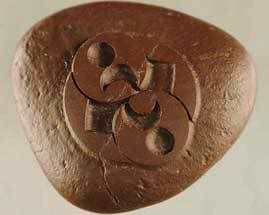
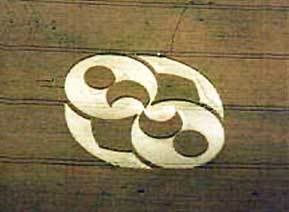 Left: Mysterious 1.96 inches (5-centimeters) by1.69 inches (4. 3-centimeters) diameter rock
that weighs 50. 78 grams, measured on July 15, 2008, in Physical Sciences Department at
Eastern New Mexico University. The carved rock was found by Roswell auto repairman,
Robert Ridge, 50, during his September 4, 2004, deer hunting trip near Capitan,
New Mexico, 17 miles southwest from the July 1947 UFO crash site between Corona
and Roswell. Image by Robert Ridge. Right: Wheat formation, 120 feet long,
reported August 2, 1996, below the Liddington Castle hill fort in Chisledon,
near Swindon, Oxfordshire, England, on Wiltshire County border.
IP: Logged |
SunChild
Moderator Posts: 4141
From: Australia
Registered: Jan 2004
|
 posted July 18, 2008 08:12 PM
posted July 18, 2008 08:12 PM
 
Aerial image by Steve Alexander.
Also see: Cropcircleconnector. com.
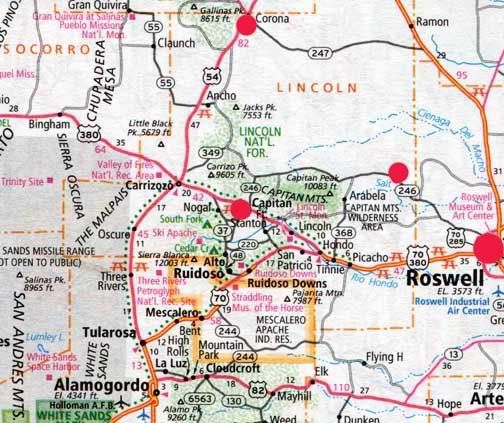 Roswell is larger red circle on far right. Cedar Hill deer hunting trail is smaller red circle
on Highway 246 (Pine Lodge Road) just west of Chavez and Lincoln County borders northwest
of Roswell. Capitan is middle red circle and Corona is top center of map. Cedar Hill deer trail is
17 miles southwest of the July 4, 1947, crash site between Corona and Roswell. Return to Roswell July 18, 2008 Portales, New Mexico - I contacted the original geologist in Portales who did the first February 2005 energy-dispersive x-ray fluorescence spectroscopy on the rock for Robert Ridge. I learned that all the original test results had been lost a couple of years ago in a computer hard crash. So, on Tuesday, July 15, 2008, I drove to Portales, New Mexico, to meet Robert for a second round of testing of the mysterious carved rock at the Physical Sciences Department of Eastern New Mexico University. The Chair of that department is Geology Professor James Constantopoulos, Ph.D., who has taught at ENMU for nearly twenty years. Prof. Constantopoulos began by examining the rock under a lab binocular light microscope. 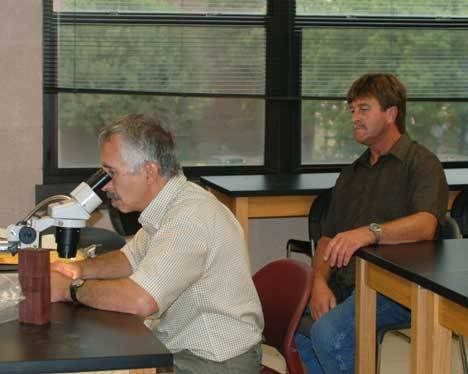
James Constantopoulos, Ph.D. , Professor of Geology and Chair, Physical Sciences Department,
Eastern New Mexico University in Portales, began his July 15, 2008, examination of the
mysteriously carved, iron-rich rock that Robert L. Ridge (right) found in the Capitan Mountain region while deer hunting at Cedar Hill on September 4, 2004. The rock is a dark chocolate color with a touch of red and has a satin-smooth finish. The rock is a bit heart-shaped, measuring 1.96 inches (5-centimeters) by 1.69 inches (4.3-centi-meters) and weighs 50.78 grams. One end is twice as thick as the other. The thickest part of the rock is where one of the circle and crescent patterns are enclosed inside a circle. Below that encircled pair is another crescent and circle enclosed inside a circle at the thinnest part of the rock. The pattern is refined with beveled edges and seems to rise more than an eighth of an inch up from the surface of the rock. Adding to the mystery, the rock pattern is a match to the extraordinary August 2, 1996, crop formation at Liddington Castle in Wiltshire, England, except that the circles and crescent moon patterns in England were created by standing wheat. In the mysterious rock, the circles and crescents are the opposite – not raised, but beveled into the raised pattern on the rock.
IP: Logged |
SunChild
Moderator Posts: 4141
From: Australia
Registered: Jan 2004
|
 posted July 18, 2008 08:12 PM
posted July 18, 2008 08:12 PM
 
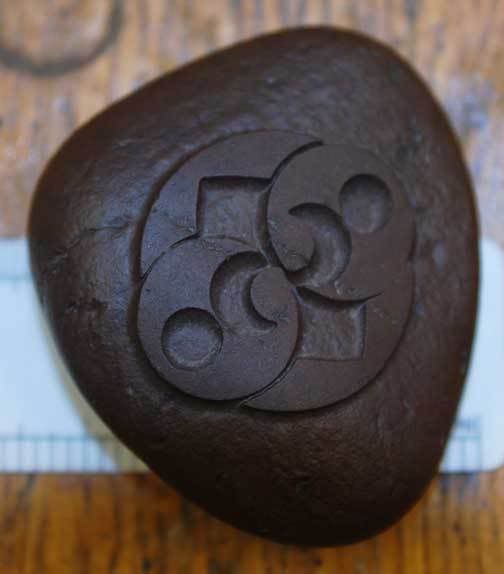 True color of the iron-rich sandstone rock and its raised pattern, which matches
the August 2, 1996, wheat pattern found at Liddington Castle. Prof. Constantopoulos first used his binocular light microscope to examine the rock on both the pattern side and back side to look at grain sizes.
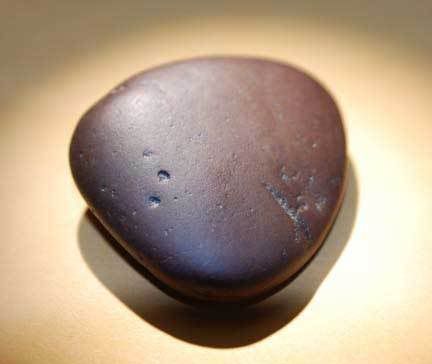
Back side of rock under lab light. Three pits were likely where larger grains fell out.
X-pattern in foreground is series of embedded calcite-like crystals.
The professor also experimented with a pencil magnet which was clearly attracted to the rock, which implied it has magnetite in it – a fact that was confirmed later when he placed the whole rock in the laboratory’s energy dispersive X-ray fluorescence spectrometry. Robert Ridge also demonstrated with his own auto shop magnet-on-a-stick. When he holds the magnet over the crescent and circle at the thickest end of the rock, the rock turns counterclockwise. When he moves the magnet to the lower crescent and circle in the thinnest end of the rock, the rock reverses and turns clockwise. Click here to see Earthfiles video of rock turning beneath magnet: http://earthfiles333. com/vodcast/ Varying clockwise and counter-clockwise plant lays are a fundamental characteristic of worldwide crop formations. Since the pattern carved on the iron-rich sandstone rock matches the pattern on the August 2, 1996, Liddington Castle pattern in England, I discussed with Prof. Constantopoulos the possibility that whoever, or whatever, made the pattern on the rock might have intended to link the upper circle and crescent to a counter-clockwise rotation and the lower circle and crescent to a clockwise rotation by utilizing the magnetite distribution in the rock or the pivot points of its peculiar shape.
http://www.earthfiles.com/ IP: Logged |
NosiS
Moderator Posts: 1264
From: )
Registered: Apr 2004
|
 posted July 19, 2008 07:58 PM
posted July 19, 2008 07:58 PM
 
Very interesting SunChild!This reminds me, for some reason of a few things. Firstly, I was browsing the net for some info on the Sacred Black Stone of Islam and I found a certain page with this writing: More Black Stones Deities of other cultures known to have been associated with stones include Aphrodite at Paphos, Cybele at Pessinus and later Rome, Astarte at Byblos and the famous Artemis/Diana of Ephesus. The latter's most ancient sculpture was, it is said, carved from a black meteorite. The earliest form of Cybele's name may have been Kubaba or Kumbaba which suggests Humbaba, who was the guardian of the forest in the Epic of Gilgamesh (the world's oldest recorded myth from Assyria of c.2500BCE and, as scholars reveal more of the text, increasingly the source of most of the major mythological themes of later civilisations [9]) [10]. The origin of Kubaba may have been kube or kuba meaning (guess what) - 'cube'. The earliest reference we have to a goddess worshipped as a cube-shaped stone is from neolithic Anatolia [11]. Alternatively, 'Kubaba' may mean a hollow vessel or cave - which would still be a supreme image of the goddess. The ideograms for Kubaba in the Hittite alphabet are a lozenge or cube, a double-headed axe, a dove, a vase and a door or gate - all images of the goddess in neolithic Europe. The stone associated with Cybele's worship was, originally, probably at Pessinus but perhaps at Pergamum or on Mount Ida. What is certain is that in 204 BCE it was taken to Rome, where Cybele became 'Mother' to the Romans. The ecstatic rites of her worship were alien to the Roman temperament, but nevertheless animated the streets of their city during the annual procession of the goddess's statue. Alongside Isis, Cybele retained prominence in the heart of the Empire until the fifth century CE; the stone was then lost. Her cult prospered throughout the Empire and it is said that every town or village remained true to the worship of Cybele [12]. The home of Aphrodite was at Paphos on Cyprus. Various Classical writers describe the rituals which went on her in her honour - these seem to include the practice which is now known by the disdainful term of 'sacred prostitution'. In any event, the tapering black stone which was the object of verneration at this Temple still survives, even if it now placed inside the site musuem [13]. Also on Cyprus is another highly venerated islamic site - the third most important after Mecca and Medina - the Hala Sultan Tekke. This, too, has a black rock, said to have fallen as a meteorite as part of the tritholon over the shrine. The shrine is to a woman - the aunt and foster mother of Prophet Mohammed [14]. Could this, like Mecca, have been originally a goddess shrine? Unfortunately no other clues are forthcoming. Another site stated to have a Black Stone was at Petra, but I have been unable to discover where this was or who was worshipped there - could any readers who know please write in! To add a little local flavour, numerous standing stones in the British Isles are reputed to have fallen from the stars. The now-lost Star Stone marked the meeting of Leicestershire, Nottinghamshire and Lincolnshire; an also-vanished stone at Grimston, Leicestershire, was also said to have such an origin. However, whether or not such stones were ever associated with goddess worship we will never know. It would take far too long to discuss to what extent the cult of the goddess's Black Stone may have been perpetrated as Solomon's bride in the Song of Songs, who is 'black but beautiful' or to come to terms with the black images of Demeter, Artemis and Isis who have their direct continuation in the Black Virgins of Europe - patrons of the troubadours, the gnostics and the alchemists, as well as the present Pope. Those who wish to follow such ideas would do well to read The myth of the goddess [15] which, in a sober but inspirational manner, re-evaluates how the feminine deity has remained with us throughout history.
http://goddesschess.blogspot.com/2008/03/black-stone-at-mecca.html IP: Logged |
NosiS
Moderator Posts: 1264
From: )
Registered: Apr 2004
|
 posted July 19, 2008 08:06 PM
posted July 19, 2008 08:06 PM
 
There is another link on that page to another interesting article relating the connection between stones and deities:
http://www.indigogroup.co.uk/edge/blston2.htm IP: Logged |
NosiS
Moderator Posts: 1264
From: )
Registered: Apr 2004
|
 posted July 19, 2008 08:23 PM
posted July 19, 2008 08:23 PM
 
My original search was aimed at the "Caabaha" which was the name of the temple that was erected in the Fourth book of the Popol Vuh. The temple was the sacred place that reportedly preserved a secret black divining stone. I came across this information from Manly P. Hall's work.I wonder if this stone has any connection to Native American mythology. All this stuff we hear about Quetzalcoatl recently, we shouldn't be too careless to not investigate. Unfortunately, I can't find anything about the "Caabaha" other than the work where I first came to encounter it (The Secret Teachings of All Ages). What do you think? IP: Logged | |

 Lindaland
Lindaland

 For The Pilgrim's Progress
For The Pilgrim's Progress

 roswell rock
roswell rock

